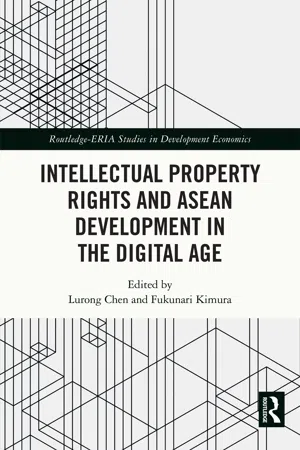
Intellectual Property Rights and ASEAN Development in the Digital Age
- 236 pages
- English
- ePUB (mobile friendly)
- Available on iOS & Android
Intellectual Property Rights and ASEAN Development in the Digital Age
About this book
The trade-investment-service-intellectual property (IP) nexus remains at the heart of economic development and the main features of which are global value chains (GVCs) and digitalisation. The protection of intellectual property rights (IPR) has become a critical issue not only for advanced economies but also for emerging markets. This edited volume contributes to the debates on IPR protection and economic development from the perspective of Association of Southeast Asian Nations (ASEAN) member states. The book provides insights into the mechanism and evidence on how effective IPR protection will increase economic and social welfare via promoting innovation activities and providing incentives to diffuse knowledge and transfer technologies.
Written by economists and lawyers from the region, these experts share their latest findings and thoughts on how countries in Southeast Asia have been progressively improving IPR protection and increasing the interoperability of different IPR regimes through regional cooperation to facilitate business operations in the context of digital transformation.
Frequently asked questions
- Essential is ideal for learners and professionals who enjoy exploring a wide range of subjects. Access the Essential Library with 800,000+ trusted titles and best-sellers across business, personal growth, and the humanities. Includes unlimited reading time and Standard Read Aloud voice.
- Complete: Perfect for advanced learners and researchers needing full, unrestricted access. Unlock 1.4M+ books across hundreds of subjects, including academic and specialized titles. The Complete Plan also includes advanced features like Premium Read Aloud and Research Assistant.
Please note we cannot support devices running on iOS 13 and Android 7 or earlier. Learn more about using the app.
Information
1 IPR protection and global value chains in the digital era With policy implications for ASEAN development
1.1 Introduction
1.2 IP in the trade–investment–services nexus of the world economy
Table of contents
- Cover
- Half Title
- Series Page
- Title Page
- Copyright Page
- Contents
- Figures
- Tables
- Contributors
- Acknowledgements
- Introduction
- 1 IPR protection and global value chains in the digital era: With policy implications for ASEAN development
- 2 IPR protection for Asian development: Opportunities and challenges from global value chains and the digital economy – Singapore
- 3 The challenges of digital economy and copyright protection in Indonesia
- 4 Intellectual property and digital technology in Thailand: Opportunities and challenges
- 5 Copyright protection in Malaysia: Development and challenges of the digital economy
- 6 Assessing IPR protection in the semiconductor and electronics industry in the Philippines: Challenges and opportunities in the global value chain
- 7 Enforcing IPR to leverage Viet Nam’s benefits from the GVCs and the digital economy
- 8 Korea’s intellectual property protection strategy and its implications for ASEAN
- 9 Patent regulatory framework in ASEAN in the light of new generation FTAs: A comparative analysis with the Andean Community and the Pacific Alliance
- Index